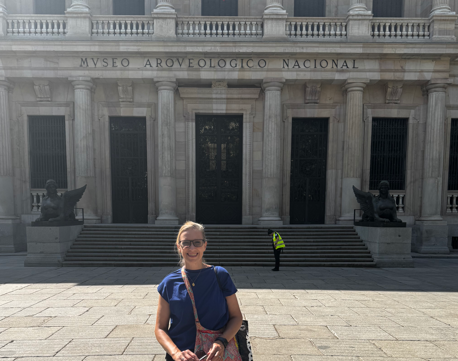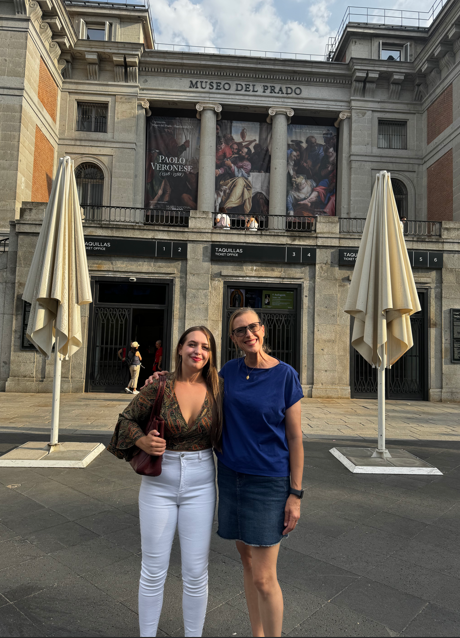

My recent visit to Madrid was built around a dual focus: studying architectural salvage traditions through the city’s premier museums and buildings, and understanding how Spain is embedding deconstruction and circularity into its building sector. The combination offers a compelling case study in how a city can value its past while engineering a lower-carbon, resource-conscious future.
Right out of the gate I learned that almost all vehicles allowed within the city are EVs (see below). Great start!
Cultural Anchors: Lessons in Preservation
At the Museo Nacional de Antropología, originally built in the 1870s by Francisco de Cubas, the act of preservation is inseparable from the building itself. Once the private collection of Dr. Pedro González Velasco, the museum has been carefully maintained and selectively updated to modern standards without erasing its original structure. This mirrors the principles of architectural salvage: preserve primary fabric whenever possible and only replace or reconfigure with care.
A short walk away, the Museo Nacional del Prado demonstrates the other side of the equation: upgrading performance while safeguarding heritage. Current works under Spain’s Recovery, Transformation, and Resilience Plan are improving HVAC efficiency, enhancing the building envelope, and integrating new systems without compromising the Villanueva building’s historic character. These interventions show that sustainable upgrades can coexist with heritage protection, a principle that applies directly to the reuse and resale of salvaged components.
Citywide Sustainability: Mobility and Air Quality
Madrid’s Madrid 360 plan establishes a citywide low-emission zone. While not fully “electric-only,” it does impose strict, tiered restrictions on polluting vehicles across the entire municipality. Since the policy’s expansion, air-quality monitoring has reported record improvements, proving that regulatory frameworks can deliver tangible environmental benefits. These policies also indirectly affect construction logistics, encouraging cleaner equipment fleets and material transport methods.
Institutionalizing Reuse: The ReMAD Platform
Madrid’s ReMAD program takes the ethos of salvage into everyday life. This municipal initiative allows residents to exchange usable items such as furniture, appliances, and other goods at designated collection points or via an online catalog. By 2024, nearly 59,000 items had been reused since the program’s launch. While currently geared toward household goods, the infrastructure and public mindset it fosters are directly transferable to architectural salvage and deconstruction workflows.
From Demolition to Deconstruction: The Legal and Policy Backbone
Spain’s Waste and Contaminated Soil Act 7/2022 now requires on-site separation of principal construction and demolition fractions during demolition activities. This effectively makes selective demolition, and by extension, salvage, part of the compliance landscape. The law also sets a national target: by 2035, 75% of non-hazardous C&D waste must be prepared for reuse, recycling, or other recovery.
Several regional and city-level pilots are turning these policies into practice:
• Seville CityLoops (EU-funded): Focused on optimizing construction and demolition waste flows, creating toolkits and logistical models for material recovery.
• Madrid Nuevo Norte redevelopment: Committed to reusing over 800,000 tons of materials and recycling roughly 90% of the remainder.
• Catalonia’s C&D Waste Program: Technical guidance and a dedicated recycling market model that prioritizes selective demolition over full tear-down.
• Private sector leaders: such as Hercal Diggers are producing certified recycled aggregates and sustainable concrete from dismantled buildings.
Tools and Standards Driving Circular Design
Spanish practitioners increasingly use material passports, BIM-based inventories, and EU frameworks like Level(s) Indicator 2.4 (“Design for Deconstruction”) to ensure that today’s buildings can be tomorrow’s salvage sources. The Green Building Council España (GBCe) has integrated circularity and reuse content into its VERDE certification, giving architects and developers a domestic rating system that recognizes disassembly-ready design.
Takeaways for Salvage and Appraisal Practice
What Madrid demonstrates, both in its museums and its demolition sites, is that heritage value and environmental responsibility can be mutually reinforcing. The museum quarter offers examples of performance upgrades without fabric loss, the city’s legal framework mandates material recovery, and pilots across Spain show that salvage and reuse markets can be scaled.
For appraisers, deconstruction managers, and policy advocates, the Madrid model offers:
1. Policy certainty: A national legal requirement for material separation.
2. Market signals: City- and region-level pilots that create end-markets for recovered components.
3. Cultural reinforcement: Public engagement programs like ReMAD that normalize reuse.
As both a cultural hub and a regulatory innovator, Madrid offers a vision in which salvaged architectural heritage and sustainable building practice are not separate domains. They are two halves of the same circular economy.
Sources
• Museo Nacional de Antropología history and architecture: Ministerio de Cultura y Deporte de España.
• Museo Nacional del Prado sustainability and restoration projects: European Commission, Spain’s Recovery, Transformation, and Resilience Plan documents.
• Madrid 360 low-emission zone policy: Ayuntamiento de Madrid, Madrid 360 official site.
• ReMAD reuse platform statistics and operation: Madrid City Council sustainability reports, 2024.
• Waste and Contaminated Soil Act 7/2022: Boletín Oficial del Estado (BOE).
• Seville CityLoops project: European Commission, Horizon 2020 circular economy pilot documentation.
• Madrid Nuevo Norte redevelopment sustainability goals: Distrito Castellana Norte and Ayuntamiento de Madrid project documents.
• Catalonia C&D Waste Program: Generalitat de Catalunya, Agència de Residus de Catalunya.
• Hercal Diggers environmental management and H-Zero plant: company sustainability reports.
• Green Building Council España VERDE certification: GBCe technical documentation.
• EU Level(s) framework: European Commission Environment Directorate.


